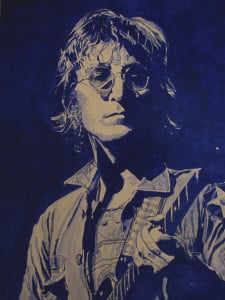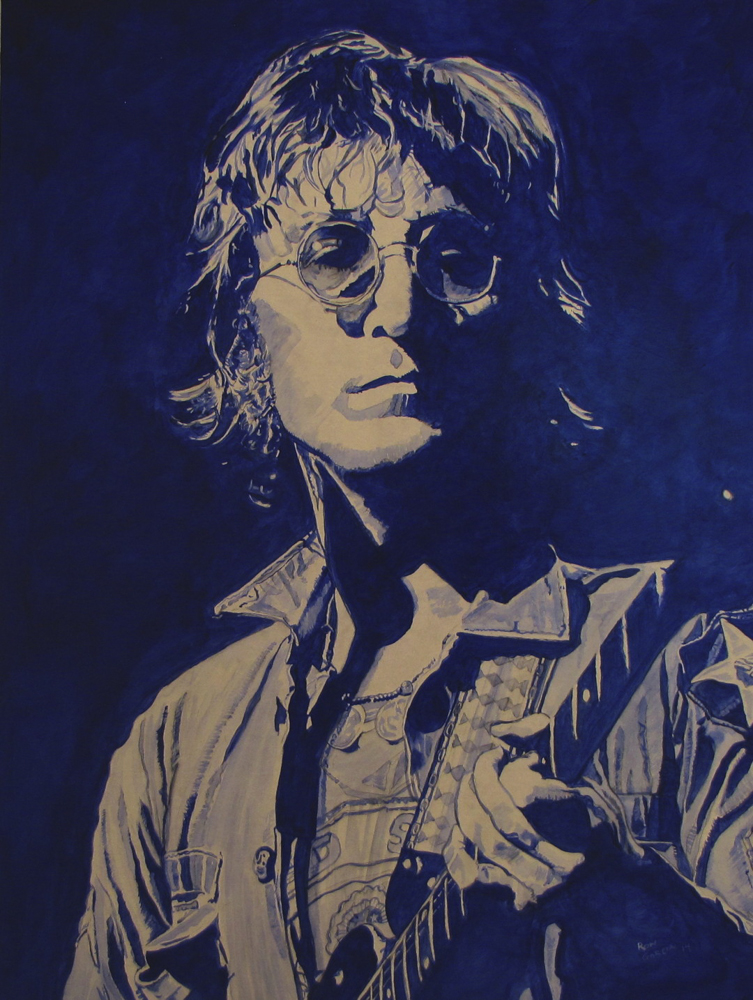
John Lennon’s 1971 song, “Imagine,” asks us to imagine a world without racial, social, religious and economic divisions. “Rolling Stone” magazine summarized it as “22 lines of graceful, plain-spoken faith in the power of a world, united in purpose, to repair and change itself.” Lennon, in an interview, said, “If you can imagine a world at peace, with no denominations of religion— not without religion but without this my-God-is-bigger-than-your-God thing— then it can become true.”
The Triton Museum of Art in Santa Clara is presenting “Imagine,” an exhibition running through August 3 that was assembled by curator Preston Metcalf, featuring works by 10 artists who were inspired by Lennon’s timely and timeless song, as well as traditions other than the prevailing scientific-rationalist capitalism.
Five of the artists look to the pre-industrial past for inspiration. Elizabeth Jimenez Montelongo uses symbols from the Nahuatl meso-american tradition, like pyramids, serpents, skulls and mystic eyes. She also uses a symbolic color palette derived from her study of Hindu chakras; her symmetrically composed, icon-like paintings like “El Fruto,” “The Moon” and “Reclaiming Autonomy” exhort us to reconsider ancient wisdom and formulate our own worldviews.
LAuruS Myth, another artist, employs archaic or mythic symbols like temples, columns, serpents, leaves, starbursts, mandalas and spiritual eyes to evoke, in works like “Initiation” and “Celebrating Creations,” a state of harmony with nature in which men and women achieve their god/goddess potential.
Jojo Perea combines mystical symbols with motifs drawn from art history and Abstract Expressionist painterly improvisation. In “Looking for Eve,” a quartet of women’s heads swirls around a recumbent Adam modeled on Michelangelo’s— a post-Christian feminist retelling of the Creation myth.
Miguel Machaca attacks the dark side to spirituality in his large charcoal drawing, “Orchestrated Religion,” a diptych representing a man and woman tortured by skull-faced angels and demons, bearing marks on their foreheads of false enlightenment. Eyes sprouting from branches of the Tree of Life symbolize evolution beyond tribal parochialism.
The other six artists mix and match more recent styles and images. Mei-Ying Dell’Aquila combines western-style realism and eastern symbolism in oil paintings like “Embrace Our Difference” and “Creation,” with Lady Liberty— an imported symbol in China, you may remember— triumphant over “the flaws of the old system” and symbolic of the merger of Societal and personal, objective and subjective. In “If Hope Had Wings,” bubbles of hope waft over an abandoned building, observed by a real bird and one of those ineffectual vinyl owls.
Sarah Ratchye paints bright, Pop paintings (with odd titles like “SpAs Born” “ and “astrOnauts Land own PlAn, KOlekt Rawx, Plant Flag”) that seem to be derived from collages of astronauts or cosmonauts, the contemporary mythic heroes of scientific-rationalist cultures, set against succulently painted swatches of advertising imagery.
Kelly Detweiler satirizes the mortgage crisis of 2008, the product of magical thinking by our Wall Street Masters of the Universe, in light-hearted yet pointed acrylics like “Meltdown” and “Bank-Owned.” Both feature bulls and bears engaged in home repossessions, with the bulls as a styiistic nod to Picasso. He indicts today’s supposedly rational monetization of everything with “Money Changes Everything” with YES emblazoned on a banner in yen, euro and dollar signs.
Patrick “WaDI” Hofmeister in his intricately painted “Octopi and Wasps,” presents an Escheresque image of interlocking animal patterns, asserting that all life is connected.
Eric Victorino juxtaposes image and text in his video-on-wall-paintings, “Don’t Say You Want a Revolution” and “All You Need is Insanely Obsessive Love.” The titles refer, of course, to Beatles songs of the late 1960s, and the block-lettered monologues muse on love and war, counterpointed by real-world video from that turbulent time. Hofmeister employs words in his unpunctuated “Run-On Sentence” placards. Finally, Ron Garcia returns us to John Lennon with a high-contract portrait in blue, and a tall, vertical painting of the lyrics of “Imagine,” a typographically unspaced modern-day column or commemorative stele.
0820 Kelly Detweiler, “Meltdown”
0821 Kelly Detweiler, Money Changes Everything”
0826 Sarah Ratcheye, “SpAs Born” (detail)
0831 Sarah Ratcheye, “astrOnauts Land own PlAn, KOlekt Rawx, Plant Flag” (detail)
0832 Ron Garcia, “John Lennon”
0839 Mei-Ying Dell’Aquila, “Creation”
0843 Mei-Ying Dell’Aquila, “If Hope Had Wings”
0848 Patrick “WaDI” Hofmeister, Octopi and Wasps” (detail)
0853, Miguel Machaca, “Orchestrated Religion” (detail)
Contact Dewitt Cheng at dewittc “at” stanford.edu.
